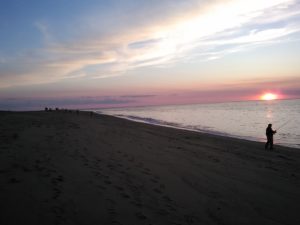Too often, environmental policy makers and park managers consider the natural environment without including humans as part of that environment. They seem to assume that a high level of human use always has a negative effect and that, to successfully manage a sensitive area, people have to be excluded from that area.
By restricting human activities to protect species and areas of interest, regulators can lose the most important aspect of conservation–the empathy of the population.
For example, consider Cape Cod National Seashore, a place that I visit at least twice a year. There is a program to protect shorebird nesting sites during certain times of the year. Certain areas of the dunes have been closed to protect nests from people and dogs; which is good. However, I have noticed a slow expansion of the project over the years, culminating last year when the beach I was walking on was totally off limits in a large expanse of area.
 I walked by a sign saying “no pets allowed” and noticed a set of coyote tracks less than a few feet below the sign. The tracks led well into the closed area. Apparently, coyotes don’t pay much attention to signs and string. As I worked my way toward the sandy point at the end of Cape Cod, the closed area extended to the waterline, blocking my path.
I walked by a sign saying “no pets allowed” and noticed a set of coyote tracks less than a few feet below the sign. The tracks led well into the closed area. Apparently, coyotes don’t pay much attention to signs and string. As I worked my way toward the sandy point at the end of Cape Cod, the closed area extended to the waterline, blocking my path.
Were the beaches closed because walking next to the water line threatens shorebirds? If this is the case, then the recovery of shorebird species is doubtful at best, because you can’t restrict all human and animal activity from every beach in their range.
It was just an easy extension of regulations to an area that is already highly regulated and preserved. Should it be a priority to increase protections of an area that is currently protected? Maybe it’s only an “important high-quality habitat” because its protected. Is increasing conservation of areas that are already restricted from development a good strategy–or is it just an easy, inexpensive thing to do?
I think protection of sensitive areas is important, but it seems ridiculous to consider an area “more important” only because other habitats have been degraded, not because it’s especially unique. The goal of policy makers should be to get visitors to the park to see a good example of why other lands should be protected or restored. Their goal shouldn’t be to exclude visitors in order to protect a habitat that’s only special because we have squandered other similar habitats.
I worry about the apathy that results from restricting national park visitors from public lands–and what it can mean for the future.
If a visitor travels to an area to go see a park, and they have limited access, do you think they’ll come back?
The recreational fishermen that used to crowd the Cape Cod beaches have all but disappeared. When people stop going to these parks, they don’t just stay home next year, they go somewhere else. They become disconnected from the places they used to visit and they become more attached to the new things they are doing. Less attachment and connection leads to less enthusiasm for conservation and preservation of the area.
One of the biggest reasons I care about conserving special places is how I feel when I visit them. That point that was closed when I walked out to it is one of my favorite places to be. I know it will slowly fade from memory if I am restricted from accessing it, replaced by other places that I can visit freely and feel welcomed instead of feeling like a trespasser.
If managers want citizens to care about preserving natural spaces, then developing and maintaining human connections to these places is the single most important element of conservation. Not keeping this in mind can destroy trust and damage the future efforts of conservationists. If protected areas are slowly taken away from citizens, then who would allow more natural areas to be managed by the government?
I think a balance can be achieved where limited damage and maximum enjoyment can coexist. A balance that can develop more trust between park managers and the public.

Very valid point. Regulators should really see the big picture and have a more realistic approach if they are going to make a “good” change.